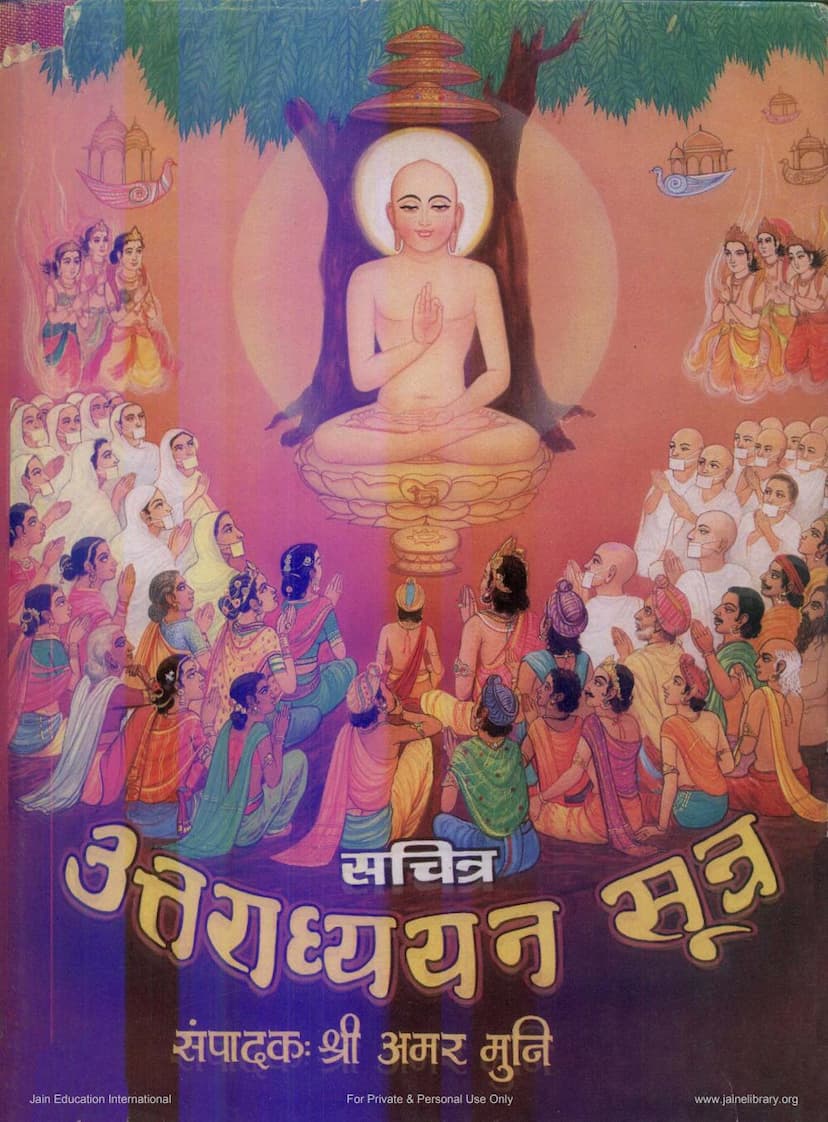Agam 30 Mool 03 Uttaradhyayana Sutra Sthanakvasi
Added to library: September 1, 2025

Summary
This Jain text, "Agam 30 Mool 03 Uttaradhyayana Sutra Sthanakvasi," edited by Amar Muni and co-edited by Srichand Surana, published by Atmagyan Pith, is an illustrated version of the Uttaradhyayana Sutra. It is presented as a comprehensive spiritual and ethical guide, considered highly significant in Jain tradition, akin to the Bhagavad Gita in Vedic or Dhammapada in Buddhist traditions.
The book aims to make the profound teachings of this scripture accessible to the general public through lucid explanations, Hindi and English translations, and importantly, evocative illustrations. This edition was published on the occasion of the Diamond Jubilee of Uttar Bhartiya Pravarttaka Bhandari Sri Padma Chandraji Maharaj.
Key Aspects of the Uttaradhyayana Sutra as presented in this text:
- Scope and Significance: The Uttaradhyayana Sutra is described as having a vast, life-encompassing subject matter. It is an "Adhyatma Kavya" (spiritual epic) that also encompasses ethics, dharma, conduct, and history. It beautifully discusses topics like karma, psychology, biology, and botany with logical reasoning. It holds immense respect and faith as the final teachings of Lord Mahavira.
- Structure and Content: The Sutra comprises 36 chapters ("Adhyayanas"), considered as 36 steps towards self-realization. Each chapter offers profound guidance for spiritual upliftment and practical living.
- Philosophical and Ethical Teachings: The text emphasizes the importance of discipline, self-control, tolerance, and constant awareness in daily life, as taught in the initial chapters. It delves into spiritual aspects, advocating detachment, renunciation, and the pursuit of the true self. It also highlights the revolutionary thoughts of Lord Mahavira and encourages critical examination of religion through intellect and pure reason.
- Emphasis on Vinaya (Discipline/Decorum): The first chapter, "Vinaya Shruta," lays the foundation by detailing the importance of discipline in the master-disciple relationship, serving the preceptor, obedience, humility, and the respectful conduct required for learning sacred texts. It contrasts the disciplined with the undisciplined disciple, emphasizing the former's path to spiritual attainment.
- Endurance of Troubles (Parishaha): The second chapter, "Parishaha Pravibhaktii," describes twenty-two types of troubles (physical, mental, social, and environmental) that a mendicant must endure with equanimity. It explains that these troubles arise from past karma but are overcome through steadfastness and self-control.
- Four Essentials for Salvation: The third chapter, "Chaturangiya," outlines four crucial requirements for achieving liberation: human existence, hearing the true religion, developing faith, and exerting oneself in self-restraint. It highlights the rarity and importance of each of these.
- Non-Negligence (Apramāda): The fourth chapter, "Asankhyam" (Irreparability), emphasizes the transient nature of human life and the need to avoid negligence. It warns against attachment to worldly possessions and relationships, as these do not offer protection at the time of death, and stresses the importance of utilizing every moment wisely.
- Types of Death (Kama-Marana and Akama-Marana): The fifth chapter, "Akama-Maraniya," distinguishes between voluntary death (Sakam-marana), faced by the wise with equanimity, and involuntary death (Akama-marana), experienced by the ignorant due to attachment and lack of spiritual awareness. It illustrates how the former leads to a better rebirth or liberation, while the latter results in suffering and further transmigration.
- The Knotless Sage (Nirgrantha): The sixth chapter, "Kshullaka Nirgranthiya," focuses on the qualities of a truly detached and renounced mendicant (Nirgrantha). It contrasts worldly attachments with the ultimate goal of spiritual liberation, highlighting the importance of renouncing all external and internal possessions.
- Parables and Examples: Subsequent chapters utilize various parables and illustrative stories to convey spiritual and ethical lessons. For instance, Chapter 7, "Urbhriya," uses the analogy of a fattened lamb destined for slaughter to teach about the fleeting nature of worldly pleasures and their eventual negative consequences. Chapter 8, "Kapiliya," uses the story of Kapil to illustrate the futility of wealth and desire. Chapter 9, "Nami Pravrajya," narrates the story of King Nami's renunciation prompted by his contemplation on unity and detachment. Chapter 10, "Drumapatraka," uses the analogy of a falling leaf to explain life's transience and the imperative of non-negligence. Chapter 13, "Chitra and Sambhuta," highlights the consequences of desires and karma, contrasting the fate of those who succumb to pleasure with those who practice austerity. Chapter 18, "Sanjaiya," presents the conversion of King Sanjaya through the teachings of mendicant Gardabhāli, emphasizing the power of spiritual realization. Chapter 19, "Mrgāputra," vividly describes the horrors of hell to underscore the importance of detachment and renunciation. Chapter 20, "Mahānirgranthiya," further elaborates on the path of a truly detached sage. Chapter 22, "Rathanemiya," depicts the story of Aristanemi and Rajimati, highlighting the superiority of spiritual pursuit over worldly pleasures and the strength of true renunciation. Chapter 23, "Kesi-Gautamiya," showcases a philosophical debate between two great spiritual masters, Kesi and Gautama, resolving doctrinal differences and establishing the supremacy of spiritual wisdom. Chapter 25, "Yajniya," critiques empty ritualistic sacrifices, advocating for inner spiritual sacrifice. Chapter 29, "Samyaktva Parakrama," through a question-and-answer format, elucidates the profound path to liberation by detailing various virtues and practices.
- Emphasis on Practicality: The text emphasizes that true spirituality is not mere intellectual understanding but a way of life, reflected in one's conduct, discipline, and constant vigilance against passions and distractions.
- Illustrative Approach: The inclusion of detailed descriptions for illustrations for each chapter suggests a visual aid to understanding the complex concepts and narratives, making the text more engaging and comprehensible for a wider audience.
In essence, this illustrated edition of the Uttaradhyayana Sutra serves as a comprehensive manual for spiritual growth and ethical living within the Jain tradition, making its timeless wisdom accessible and impactful.